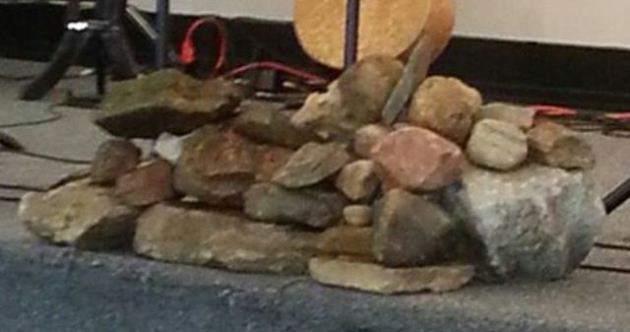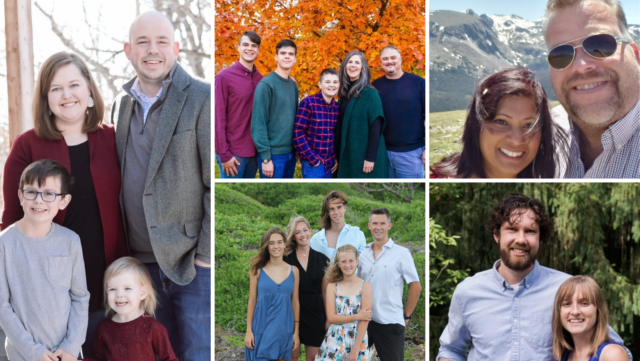Jenny Gravely did what most planters wouldn’t dream of let alone think possible – she planted a Vineyard church in Fulton, OH population 259. The Vineyard Church of Morrow County became an instant megachurch in the village with 50+ people showing up any given Sunday.
In March 2014 Jenny resigned to relocate to Florida to do another Vineyard plant. Jerry Stephens became the second pastor of a tiny little church in a tiny little town.
Following a dearly loved pastor in a fledgling 2 year old congregation is a tough calling. What follows is an interactive exercise Jerry has used often in the past. He used it again at VCMC to reunite and re-mission the entire church.
To prepare Jerry collected enough rocks for everyone to have one with a fair number left over. Most of the rocks were about double-fist sized but some were bigger, some smaller. Jerry is adamant that he won’t pick up just any old rock. In fact, he has been known to spend hours collecting just the right rocks! Each rock must be local (from around here!) and each one must have character. For reasons that will become evident as the story progresses, he looks for rocks with chips, fractures, embedded fossils, veins of rusty iron, etc.
Imagine walking into the 100+ year-old church building on the first day of the new pastor. The front of the sanctuary is lined with a bunch of rocks laid out for everyone to see. Everyone has an opinion what the rocks mean. Jerry just smiles; no one is even close! Here is the message Jerry shared.
We’re not the first to face a transition from a beloved leader to a new guy. Both in scripture and down through history, others have had to go through the difficulty of leadership change. Let’s take a look at one such transaction.
The story comes from the opening chapters of Joshua. After forty years wandering in the wilderness Moses has led the children of Israel within sight of the promised land.
As chapter one opens, Israel is poised on the banks of the Jordan River, about to cross over into what they have been told is the ‘promised land’. This is my very loose summary of Joshua 1. The beloved leader, Moses has passed from the scene (the last chapter of Deuteronomy tells the story). The mantle of leadership has passed to Joshua by virtue of the explicit call of God. The Lord said to Joshua, “Now then, lead my people into the land I am giving them. As I was with Moses, so I will be with you; I will never leave you or forsake you. Be strong and courageous, because you will lead these people into what I have promised.”
As the ‘new guy’, I’m a bit overwhelmed by the responsibility of caring for the eternal souls of those in this household of God. I am painfully aware of just how inadequate to the task my natural abilities are. I take a lot of comfort and encouragement from what God said to Joshua because I am convinced that in those words the Lord reveals his intention for every person he calls to lead the people of God. What’s going on in my mind is, “The task is huge and the responsibility is mind-boggling,” to which God replies, “Don’t worry, I’ve got your back. Be strong. Take courage. Lead those I’ve entrusted to you into what I’ve promised.” Whew! I feel a lot better now!
What about the Israelites, covered as they were with 40 years’ worth of dust from their wanderings in the desert? Try to put yourself in their sandals. What must it have been like for them as they gazed across the flooded river? Bewildering? Scary? Exciting? Those and forty-two more emotions must have welled up within.
Kind of like what some of us feel when we’re faced with momentous change. Perhaps we can learn a lesson or two from their experience.
Moses, the recently departed leader, had prepared the people. Now it was time to move forward.
I love what Joshua did first. Joshua 3.5 tells us, “Joshua told the people, ‘Consecrate yourselves, for tomorrow the Lord will do amazing things among you.’” Wow! What a great first ‘step’ on their journey. What better first step could we take on ours? Let’s consecrate ourselves (devote ourselves wholly to God), because it is his promise and our confident belief that he will do amazing things among us.
The text tells us that the Jordan River was a raging torrent at that time of year. How scary must that have been? Nonetheless, the people got ready to go.
As soon as they waded into the water, just a short distance upstream, the Jordan piled up in heap. I’ve seen lots of ‘heaps’ in my day, but I’ve never seen water heaped up! That must have been quite a sight!
And the people—all two million of them—walked across a dry river bed. Chapter four opens with them standing on the opposite river bank. Let’s read the biblical account of what happened next:
When the whole nation had finished crossing the Jordan, the Lord said to Joshua, “Choose twelve men from among the people, one from each tribe, and tell them to take up twelve stones from the middle of the Jordan, from right where the priests are standing, and carry them over with you and put them down at the place where you stay tonight.”
So Joshua called together the twelve men he had appointed from the Israelites, one from each tribe, and said to them, “Go over before the ark of the Lord your God into the middle of the Jordan. Each of you is to take up a stone on his shoulder, according to the number of the tribes of the Israelites, to serve as a sign among you.
In the future, when your children ask you, ‘What do these stones mean?’ tell them that the flow of the Jordan was cut off before the ark of the covenant of the Lord. When it crossed the Jordan, the waters of the Jordan were cut off. These stones are to be a memorial to the people of Israel forever.”
There are several important lessons to be learned from this story about a pile of rocks. None is more important than this: God’s faithfulness in the past is what makes our confidence in his future faithfulness more than mere wishful thinking.
Indeed, his faithfulness is the foundation of our faith. Rock solid and secure.
Here’s something worth pondering: In what ways has God been faithful to you in the past?
As you are pondering that come up here and choose a rock. Don’t just pick any old rock but rather select one that in some way represents you or represents God’s faithfulness in your life.
(After everyone has had a chance to select a rock): Take a look at the rock in your hand. Think about what it represents. Remember in as vivid detail as you can the faithfulness God has shown you. As you remember his past faithfulness, consciously—perhaps even vocally—proclaim how those precious memories serve to strengthen your faith. Begin to proclaim before the Lord your confidence in his promises.
(At this point I asked a few pre-selected people to briefly share their story of God’s faithfulness to them and why they chose the rock they did. Afterward, we spent a few more moments vocally praising God),
Remembering is great, but our remembering in this way must have a purpose. And so it does. Now that you have your own special rock or remembrance I want you to bring it back up to the front and help us create our own ‘pile of rocks’. As you place your rock on the pile state out loud what it is that you believe God is going to do in our midst—perhaps bring salvation to your household, or bring healing to your sick grandmother, or an answer to a bad problem in the schools. Whatever it is, remember that your belief is by faith based on God’s past faithfulness to you.
(After the stone altar was built I invited the congregation to take a few more minutes to simply praise God)
Epilogue: At the conclusion of the service I asked everyone to come back and get their rock. I told them to take it home and put it in a prominent place. I asked them make a conscious effort each time they see their rock to remember God’s past faithfulness and to renew their faith for whatever it was they said when they put it on the pile. I told them that inevitably someone will ask them, like Israel’s children of old, “What’s with the rock?” I reminded them what a great opportunity that would be to share their story about God’s faithfulness. In the weeks that followed I had people share their stories about people asking about their rock! To this day, when I visit people’s home, many of them still have their rock prominently displayed!
Here’s a photo of our VCMC ‘Pile of Rocks’ created on March 9, 2014. Beautiful, isn’t it?

********************************
About the Author
Jerry has been engaged in pastoral ministry in one form or another since 1979 and has been involved in the Vineyard movement since 1992. In addition to his pastoral role, he has also run Ministry Consulting Group since 1989. MCG provides administrative, financial, tax and other services to churches and non-profits. His official installation as pastor of Vineyard of Morrow County occurred on Sunday, April 13, 2014. Jerry and his wife recently increased the population of Fulton, OH to 261 by moving there themselves!





